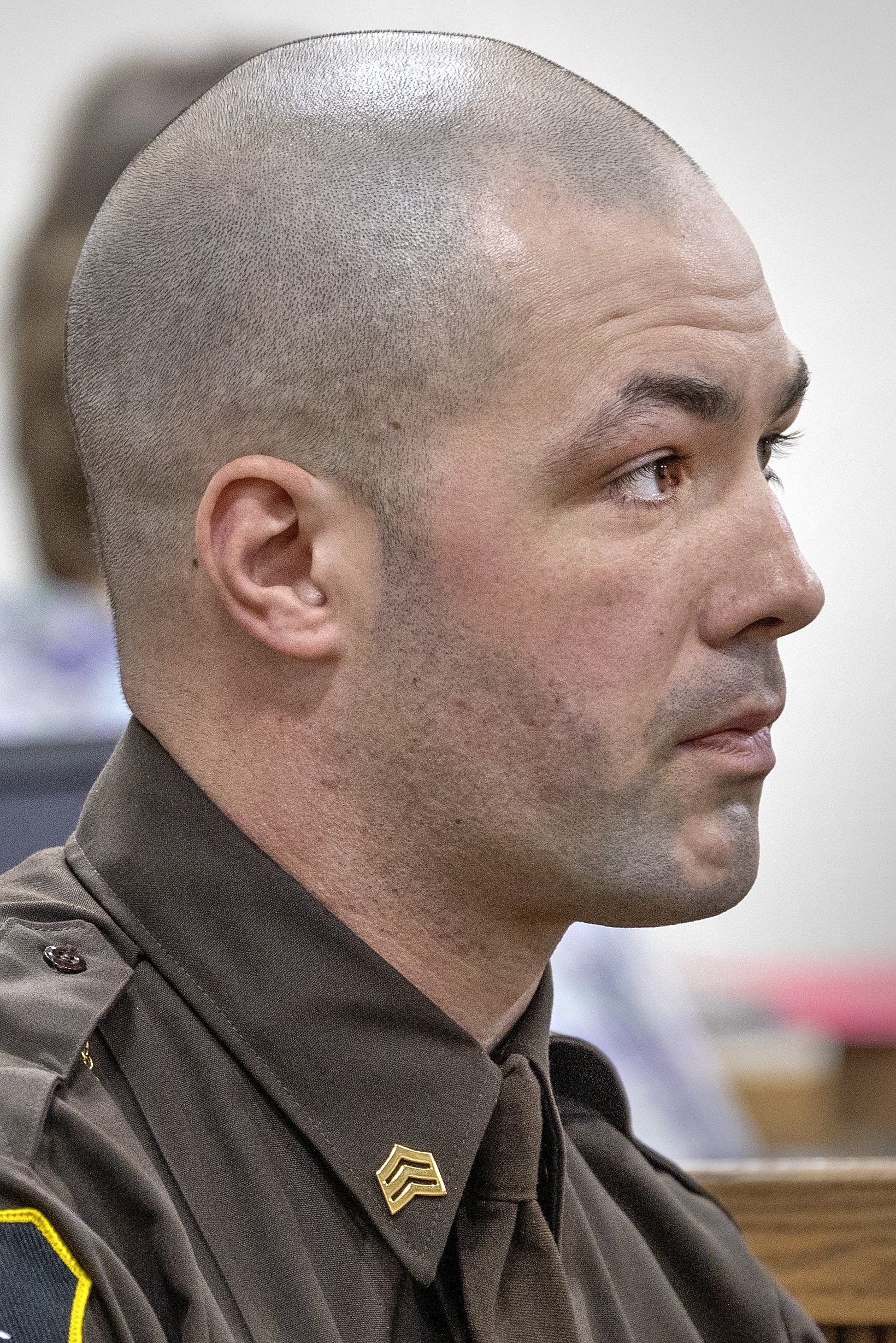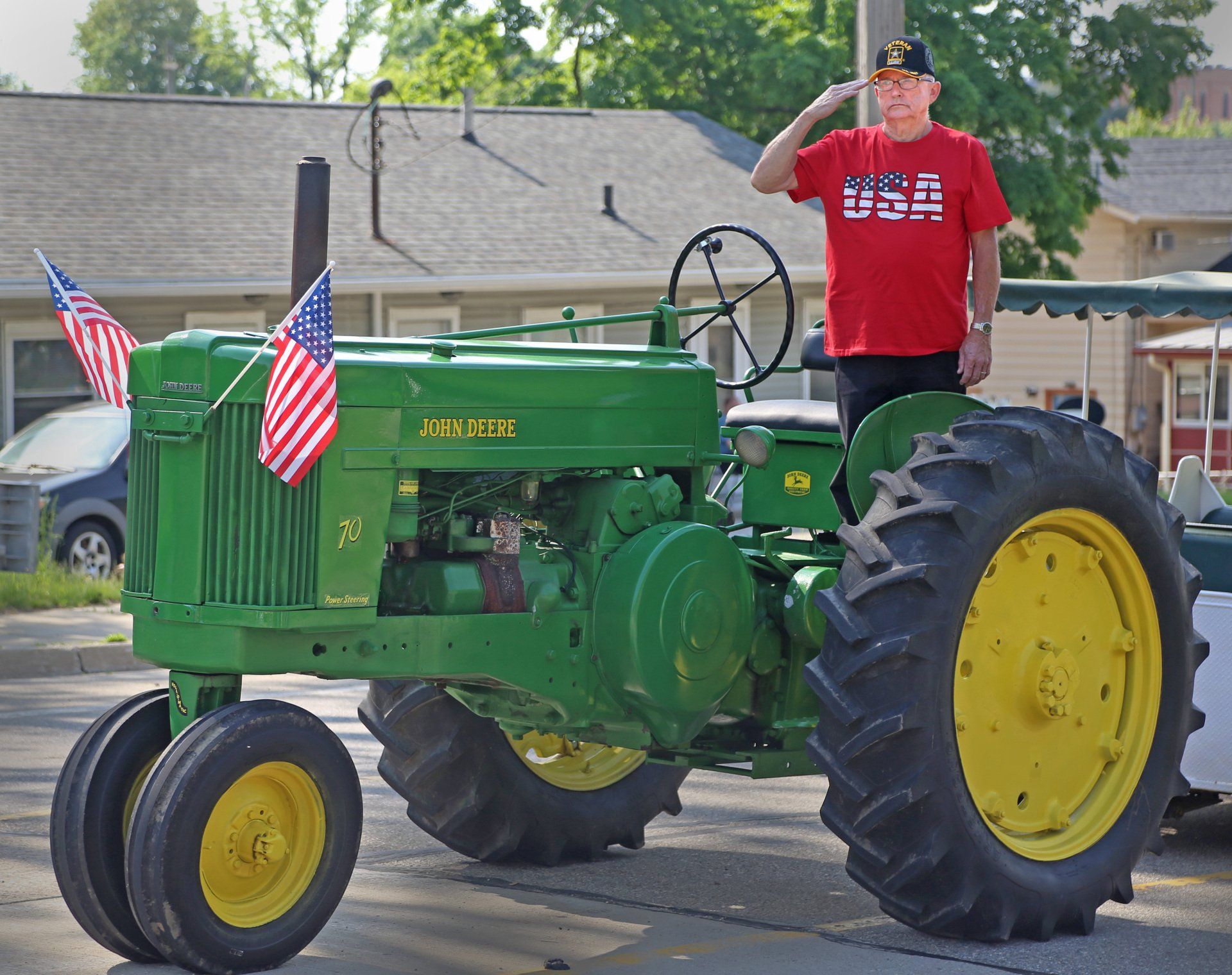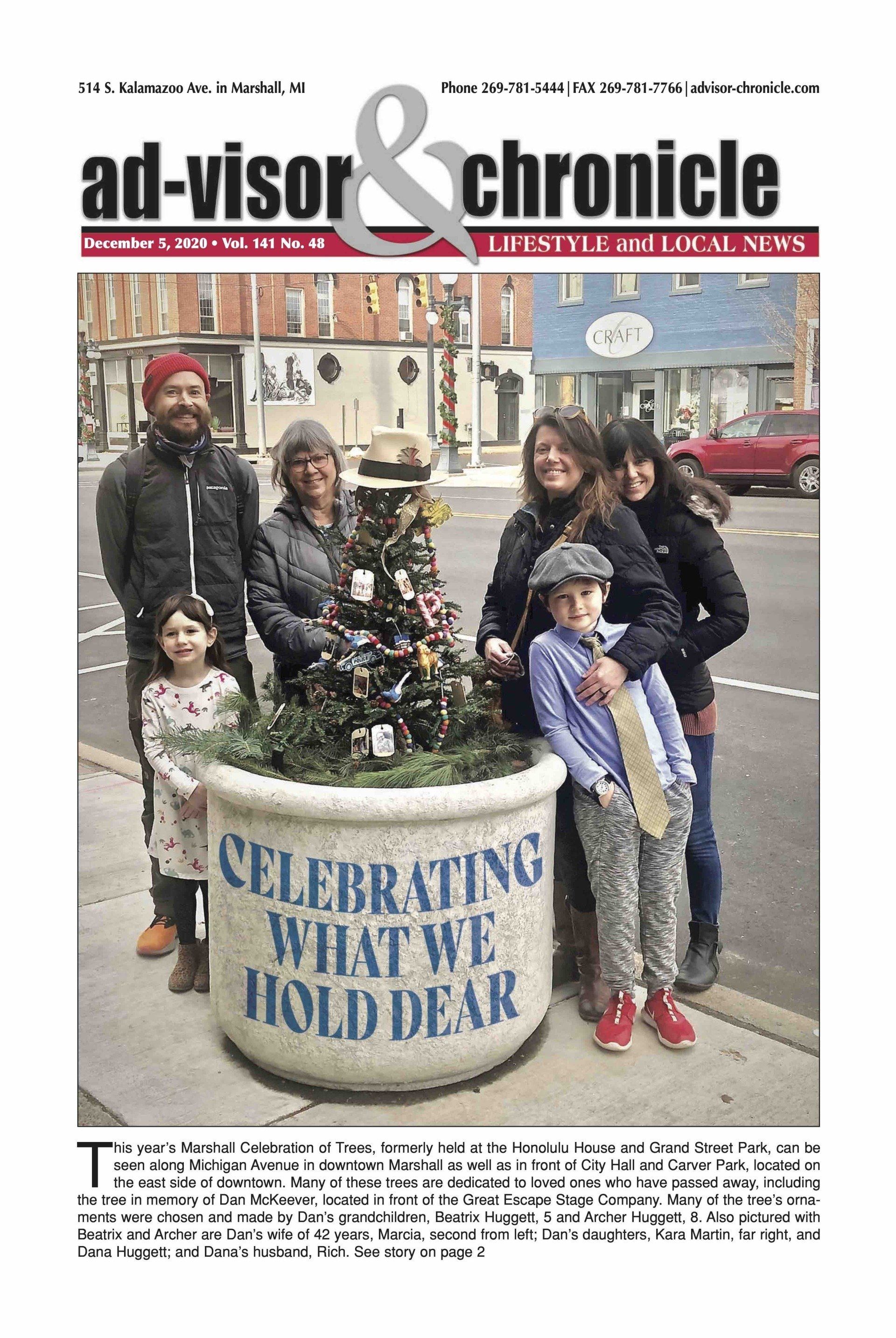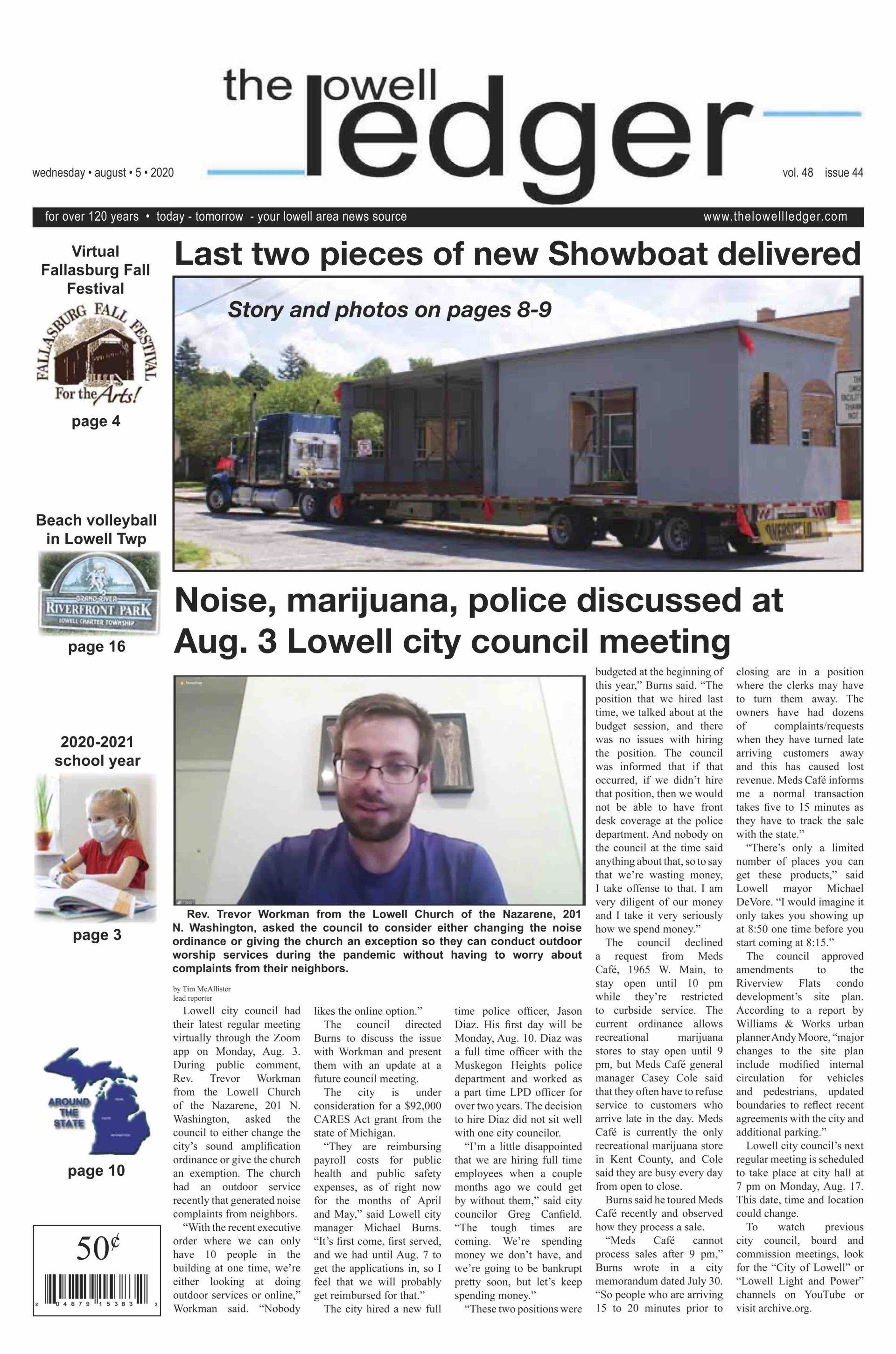What the school bond request means to Hastings
Benjamin Simon • February 10, 2022
Sandy Greenfield graduated from the Hastings Area School System. Her kids graduated from Hastings and her grandkids will graduate from Hastings.
“We used to joke about bleeding blue and gold,” Greenfield said.
Greenfield, the Rutland Charter Township treasurer, said she always votes yes on school bonds. She has spent nearly her entire life giving back to the district, she said, and, for 25 years, she has worked backstage at the musicals.
She has seen firsthand why the school district needs the upgrades.
“I went to high school in the old middle school,” she said. “I did the tour. I saw what that gym looks like. I knew how terrible that was.”
A few weekends ago, Greenfield moved, cleaned and tagged books in the library at Central Elementary, where her daughter works. They had to close all of the shades to insulate the building, Greenfield said, because the decades-old single-pane windows let in so much air.
Yet, as a township treasurer, people often stop in and talk about the bond. She said she hears murmurs of distrust, distaste for more taxes and feelings of disillusionment.
“The general feeling from people that come in to pay their tax bill for me is that they don't really have a lot of faith and trust in how their money is getting spent,” she said.
The school district’s most recent bond request failed Aug. 3, 2021, marking the fifth time in four years voters rejected a bond proposal. It has crystallized one of the most polarizing issues in the Hastings community – and that didn’t start after the last bond election. Or the one before that. Or the one before that. It has existed for decades.
School officials aren't giving up.
In three months, on May 3, they will ask for a bond that follows the same scope as the one voters denied in August.
The May 3 bond request
When Superintendent Matt Goebel talks about why this bond request is so important, he tells a story that dates back to May 2015. That’s when the district asked voters for a $55 million bond.
It failed.
So they returned to the voters six months later in November. This time, they pared the request down to $44.6 million. They asked for essential fixes, a new section of the middle school and a state-of-the-art performing arts center.
It passed.
That was the last bond that passed. Ever since then, school district officials have continued to ask voters for the rest of the funds they needed seven years ago, hoping to finally complete the maintenance upgrades that were left out of that Nov. 2015 request.
Now, Goebel said, it's “the fourth quarter.”
“I would define this as finishing the job for the basic needs of the district,” he said.
That’s part of the reason they decided to come back with the same request that failed in August 2021.
Goebel, who took over as superintendent in March 2021, can’t emphasize it enough: The issues they face haven’t disappeared and the longer they wait, the more the district will falter.
“These are our dire needs,” he said. “There was nothing to cut.”
The proposed bond would generate $23.9 million in revenue with a focus on districtwide maintenance upgrades to its aging infrastructure. Single-pane windows at Star and Northeastern elementary schools date back to 1954. Bathrooms at the elementary school date back to 1930. Locker rooms at the middle school date back to 1954. Locker rooms at the high school date back to 1970. Parts of the roof at the high school, the largest price tag, date back to 1997.
As a kid in late 1970s, Bob Gaskill remembered walking on the benches in the middle school locker room and thinking “oh, man, this place is old.”
Fifty years later, he said, “it’s the same thing. There hasn’t been a change since. … The tile screams 1950.”
The district has gotten the most out of these buildings, added Gaskill, a parent, volunteer and lifelong resident of the district.
But it’s time for a change, he said. "I think one of those things that we can show our community and our kids is, ‘if taken care of, things can last a long time.’ And I think that should be emphasized because we have taken care of it. But then there does come a time when they can give way to newer things that are more efficient and built better, quite frankly, and safer.”
The bond also would cover a number of upgrades, such as new security cameras across the district, playground equipment at Northeastern, a repaved parking lot at the middle school and the removal of asbestos and the installation of a PA system at the high school.
The dollars can only go toward the proposed projects, which were approved by the state. In October, the district received a clean independent audit of its expenses from the 2015 bond, meaning it used all of its funds correctly. '
The bond would raise the Hastings Area School System tax rate from 6 mills to 6.8 mills – down from 6.9 mills in place during the 2015 bond. They are committed to paying off the debt in fewer than 15 years, even though most districts do so in 25 to 30 years, Goebel said.
That 0.8 of a mill would equate to 80 cents per $1,000 of taxable value. The average homeowner in Rutland, for example, Sandy Greenfield said, has $119,872 in taxable value – meaning they would pay about an additional $100.
Goebel said it was their priority to keep the tax rate low. “I don't think it's right to ask for more than what is needed,” he said. “I would say I'm pretty fiscally conservative when it comes to taxes and when it comes to what we need. Since my time here, I think I've shown that.”
From a taxpayer standpoint, Gaskill said he feels like he’s saving money in the long run by voting for the bond, adding it is a “return in investment” for the people of the district.
“It makes good business sense,” he said. “There’s a reason why, for the last 20 years, businesses have been changing over to LED lighting – it saves them money. There's a reason why they went from single-pane windows to double- and triple-pane windows – it saves them money. And if businesses are doing that to save money, why not do the same as good stewards?”
Why people vote “no”
On a Monday morning in late January, 11 people sit around a table in the Baltimore Township Hall. Most of them said they will vote “no” when the bond goes to the polls May 3.
They bristle at the thought that they’re anti-schools. Many attended the Hastings Area School System and have spent nearly half a century living in the district.
“We don't want to be considered just the constant bitchers and the constant no-people,” said Dowling resident Linda Mellen. “But work with us. They aren’t willing to work with us.”
“We’re the outsiders,” Jackie Whitmore, another Dowling resident, responded. “We don’t live in the city.”
Fundamentally, it starts with money. And money is tight, they said, especially after the pandemic. Whitmore called the timing poor for a bond request.
“$100 to some people is probably nothing,” she said. “But, to others, it means a whole lot – whether their bill gets paid for electricity this month or whether they’ve got food on their table. So pooh-poohing $100 is not a good thing.”
If people give their money somewhere, even as much as $100, they said they want to trust that the people who handle their money will use it in their best interests and the interests of their kids.
“You're getting into people's pockets and that upsets people,” Whitmore said. “When you start taking money out of people's pockets, they are not going to like it.
“That's the bottom line.”
This is especially true in the rural townships. Sixty-one percent of residents in the City of Hastings, for example, supported the August 2021 bond proposal. But, with the exception of Rutland, residents of the other townships voted largely against the proposal. Only 36 percent of residents in the townships of Assyria, Baltimore, Carlton, Castleton, Hastings, Hope, Irving and Johnstown voted for that bond request.
For starters, the people at the Baltimore Township meeting said they feel like the school district doesn’t represent them, it looks down on people in the country and it doesn’t listen to their concerns.
“I graduated in 1965 from Hastings High School and it was that way back then,” said Richard VanSyckle. “... If you didn't go to this church and that type of thing, you weren't in the clique.”
The list of reasons for voting against the bond is long and personal. For some, it dates back to a slight that a previous superintendent made or a football coach who benched their kid. For others, it’s the decrease in vocational classes in the district.
For many in Baltimore Township, it’s the closing of the Baltimore Township-based elementary school, Pleasantview, in 2008.
Today, not a single school building lies in Baltimore Township. Residents can’t walk to their school or football games. They have to get on the bus at 6:30 a.m., Supervisor Chad VanSyckle said, to make it to school on time. That area worked hard to build up Pleasantview, VanSyckle said, and they felt abandoned when the district closed it. Due to poor financial straits then, district officials decided to close the school, which was running at half capacity, to save money.
Fourteen years have passed. Superintendents have changed and school board members have come and gone, but the memory of Pleasantview still looms large in that township.
“As far as Pleasantview School out here, it just really irritates me,” Whitmore said. “That was a perfectly good school. No issues out there ...
“Now they want us to pay for [the bond], but they took our school way out here. That was wrong. Just plain wrong.”
The 11 people sitting in the Baltimore Township Hall might not all have the same issues with the district, but they do have the same desire: They want to be heard. Transparency, they said, is the most important issue for them.
“We want to be taken seriously,” Mellen said.
Voting is their form of defense, VanSyckle said. It's a way to demand the attention of the district and “yes” voters. To him, voting “no” doesn’t mean he disapproves of schools, it’s a way to force district officials to hear their concerns and improve the schools.
“At least this way, I'm frustrating them,” VanSyckle said. “... [Voting no] is not changing nothing, but at least it’s not throwing money at the problem. I work hard for my money.”
The bond request strategy
Supporters of the bond acknowledge that the scope of the bond hasn’t changed since August, but their campaign strategy has. Goebel said he listened to the concerns of voters after their request failed in August and, this time, he plans to be “even more transparent.”
“If you're more and more open with people, they can have an understanding of the overall strategic plan,” Goebel said.
The district sent out a newsletter to every home in the district, detailing a timeline of how the district used its funds from the successful 2015 sinking fund. Goebel started writing a column in The Banner, “Superintendent's Corner,” where he updates readers on the status of the school district. Last week's column broke down how and where the district has used, and will be using, its COVID-19 relief funds.
In coming weeks, supporters of the bond plan to advertise in local media outlets and post on social media. They will attend service club and township meetings, and send people out into the community to speak to voters face-to-face. This in-person interaction is important to the campaign, Steering Committee Treasurer Justin Peck said.
“You put a face to someone, they're more like to buy into it,” he explained.
Part of the changes also feature the implementation of a steering committee, separate from the school district, comprised of five well-known community members, including Danielle Storrs, chairwoman; Justin Peck, treasurer; Jeff Domenico, secretary; Chris Cooley and Fred Jacobs. The steering committee will help devise a strategy that will direct the 70-person citizens' committee that will work on the ground and connect with residents.
“[The steering committee] was created to have this bond come from the community,” Peck said.
But successfully running a bond campaign is a challenge. In 2016, the Michigan-based Bridge Magazine looked at 1,600 bonds proposed over a 20-year period. Of that total, 51 percent passed.
Brett Geier, a Western Michigan University professor of Educational Leadership in K-12 Leadership who studies school bonds, called successful millage campaigns both a “science and an art.”
Geier said he has found inequities between rural and suburban/urban districts when levying bonds.
In Metro Detroit or Grand Rapids, for example, property values are higher, allowing the districts to generate more money from a lower millage rate. Rural communities, however, which often have less industry and lower home values, don’t have that same luxury.
While, on average, urban and suburban districts levy the same millage rates, Geier said he has found that rural districts typically levy millage rates 1.5 times higher than their counterparts.
In Hastings, the circumstances represent more of a challenge. The school district has to connect with a wide array of voters, stretching from the City of Hastings to the more rural Baltimore Township, where the economy, infrastructure and needs differ. The district covers a total of 173 square miles – over 50 square miles more than the neighboring districts of Thornapple Kellogg or Delton.
Goebel said Hastings Area School System has made an effort to work in the townships. They run a recycling program with Hastings Charter Township, for example. They send kids to sing at Thornapple Manor and help rake leaves for the elderly.
To educate people across the community, Peck and the steering committee are developing “an advocacy plan.” They are breaking down all of the minor details of the bond – each dollar they will use and each upgrade they will make. In past elections, people have questioned why the district continues to ask for the same facility features.
But with thorough, detailed and consistent transparency, the steering committee hopes to show voters that these are different roofs, different lights, different security upgrades than past successful bonds. They said they hope to show where, how and when the district would use its bond funds.
And, if the request is successful, they will update the taxpayers regularly on how those funds are being spent.
They also are focusing on increasing voter turnout. Only 3,000 of 15,000 registered voters went to the polls during the Aug. 2021 election. And this, supporters of the bond said, is an issue.
“20 percent of the people are making the decisions in this community about something that everybody has a stake in,” said Gaskill, a citizens’ committee member.
They have requested records from the Barry County clerk's office for every registered voter in the Hastings Area School System. They can’t see how people voted, but they can see who voted in the August 2021 bond election. From there, the steering committee plans to work with the citizens' committee to identify people who “advocate for the schools” but did not vote, Peck said. The citizens’ committee will then get out in the community and make an effort to engage with residents.
“In any part of life, you talk to someone who plays in your basketball league and they're chatting with you about a vote or anything, you're more likely to listen to them,” he said.
With their emphasis on transparency, Peck intends to reach “no” voters naturally and quell some of their concerns. Goebel said he’s open to speaking with anyone – “yes” or “no” voters.
“The hope is that we change the mind of 'no' voters with some of these things we're doing,” Peck said.
'You can never talk to people enough'
Before Brett Geier became a professor at West Michigan, he served as the superintendent with Bloomingdale Public School.
With just 1,200 students, Bloomingdale is smaller than Hastings. But it’s also rural and features various “distinct” communities, Bloomingdale, Pullman and Grand Junction, folded into one district – which is 30 minutes west of Kalamazoo.
Over a year before proposing a bond in 2007, Geier knew that he would have to earn the trust of his constituents, especially “no” voters. The district needed $5 million and a new turf football field – a tough sell in any community.
“The actual work of having people included takes the extra effort,” he said. “It takes effort to reach out to places that may not just be around the corner.”
So Geier brought voters into the district’s buildings to see where their money would go. He held superintendent coffee sessions and visited the barbershop. He met people “on their turf,” as he called it.
“Now that doesn't necessarily mean sending a newsletter,” he said, “but it means ensuring that activities are done in those communities, that we intentionally target those communities. We don't just assume that they feel a part of the school, but we have to make them a part of the school.”
Geier didn’t want to make everything centered around Bloomingdale, where the high school is located. He wanted to make sure activities went on in the surrounding communities, asking the basketball coach to hold practices in Pullman, for example.
He also identified one of the district’s major bloc of no-voters: Seniors.
A year and a half before the vote, Geier began holding weekly senior lunches. But the lunches weren’t just bond-focused. Instead, they created an opportunity for people to socialize with each other.
Still, he made it a point to always bring in something from the schools – like a class of kindergarteners to sing a song. And, by the time the bond came around, he had created relationships with the residents. When he finally did give a presentation about the bond, they listened, asked questions and understood more about the district and why it needed the money.
“You can never talk to people enough,” he said.
His efforts worked.
The bond passed.
It's been 15 years – and the district hasn’t asked for another bond since.

A new court date has been set for a 24-year-old Battle Creek man accused of threatening campers at the Welcome Woods campground in Carlton Township last month. Trevor Dean Leiter is scheduled to appear for a probable-cause conference June 15 in District Court 56B. A conference had been scheduled for last week but was adjourned, court officials said. Leiter is charged with three counts of felonious assault and one count of reckless use of a weapon in connection with the May 16 incident at the campground on Welcome Road, north of the city of Hastings. Michigan State Police received a report of a domestic dispute involving the suspect and his girlfriend. Prior to troopers arriving, Leiter threatened people at the campground and started “shooting rounds into the air from a handgun he had pulled out of a backpack,” the Barry County Sheriff’s Department reported. When troopers arrived, Leiter initially refused to exit the RV, and officers surrounded the vehicle. The Barry County Sheriff’s Department Special Response Team was called to assist. “Members of the SRT were able to quickly control of Leiter and handcuff him to the rear [of the RV],” the sheriff’s department report said. “After standing him up and trying to escort him to a patrol vehicle, he began resisting. Leiter had to be pushed towards the patrol vehicles. Leiter became more resistant and had to be brought down to the ground and held down.” Once in the patrol vehicle, Leiter kicked at the windows in the vehicle. Then at the jail, Leiter continued to resist corrections officers and had to be placed in a restraint chair, according to the sheriff’s department report. The girlfriend escaped without injury, and no one else was hurt in the incident. Leiter is being held on a $10,000 bond in the Barry County Jail.

Sgt. Scott Ware with the Barry County Sheriff’s Department received the 2022 Police Officer of the Year Award for his actions during an Aug. 4, 2021, car chase and shootout in Woodland. Ware was recognized by the Police Officers Association of Michigan at its annual convention in Grand Rapids. “For bravely putting the lives of others before his own by stopping an armed shooter before he could do any real harm, Sgt. Scott Ware is one of the Police Officer of the Year award recipients,” a press release reads. “The teamwork of all officers on the scene and the courageous, tactical decisions of Sgt. Ware allowed the whole incident to end without any civilian or police officer casualties.” Undersheriff Jason Sixberry said the department is lucky to have Ware. “Scott’s done a great job here and with everything he’s done to keep the community safe,” Sixberry said. “We’re proud of him and his accomplishments and him receiving the award. It’s a pleasure of ours to have him go from a deputy up to a sergeant position, being able to instill his good values and hard work ethic in the department.” The encounter started when police were alerted that Timothy Riddle was suspected of stealing two shotguns from a Hastings resident on the 1000 block of North Coville Road. Police in the area were notified to keep a lookout for Riddle. A Hastings City Police officer saw Riddle’s vehicle at a gas station on M-43 in Hastings at 6:48 p.m. that night. Riddle was stopped by police as he was leaving the station. When police started to question Riddle, he grew agitated and sped off, heading north on M-43. Police reports and testimony in court said Riddle reached speeds as high as 115 mph. Officers from the city police and the sheriff’s department, including Ware, joined the chase. Police reported that Riddle pointed a shotgun out the window at pursuing officers throughout the chase. The chase ended at the Mobil gas station parking lot on M-43, east of Woodland. Police reported that Riddle leveled a shotgun at officers after exiting his vehicle and began approaching them. Ware, who was still inside his police cruiser, readied a rifle and fired several shots through the windshield of his vehicle. Those actions are credited with causing Riddle to stop shooting and retreat into the gas station. One customer escaped and two employees hid inside the store. They later were able to leave the station unharmed, police report. Riddle barricaded himself inside the station for seven hours while police negotiated with him. The standoff ended at 1:30 a.m. when Riddle surrendered himself to police. He was later convicted of 21 criminal counts. During Riddle's trial, Barry County Judge Michael Schipper reviewed the incidents as they had occurred that day. Remarkably, the judge pointed out, no one was hurt. That was because of the police officers who responded to the scene, he said. And Ware was a key reason for that, according to the police officers association.

Despite a near 90-degree forecast, a strong breeze from the south kept participants and spectators comfortable as the annual Memorial Day parade wound through Hastings Monday morning. The event, hosted by Lawrence J. Bauer American Legion Post 45, made its traditional stops, pausing at Tyden Park and the bridge over the Thornapple River before ending at Riverside Cemetery. The parade stepped off at 9:30 a.m. from the intersection of Boltwood and State streets, with the Legion’s color guard, followed by the honor guard, Legion members and other veterans, National Guard and Reservists, Legion Auxiliary, Legion Riders, the local Disabled American Veterans chapter members, Sons of the American Legion, Scouts, Hastings Area Schools Marching Band and other participants. They walked through downtown, making their way to the Veterans Memorial at Tyden Park, where attendees heard a speech from Steve Carr, an Air Force veteran. Carr served as the commander of Post 45 for three years before taking over as the current Michigan District 4 forward commander. He began his speech by honoring the final 13 U.S. service members who lost their lives in Afghanistan. He shared a little bit about each person – their names, where they came from and details about their lives. “Not only are these diverse men and women forever in our hearts, but for those who knew him, they are forever young,” he said. “They came from every background, yet they shared a common goal: To serve America and make life better for others.” Carr went on to highlight the importance of Memorial Day. “Memorial is not about picnics and parades, though there is nothing wrong with enjoying and celebrating our American way of life,” he said. “Memorial Day is about gratitude and remembrance. It is about honoring the men and women who made it possible for us to gather here today in peace. But the reason there is a Memorial Day, the reason we gather here, is to remember who made our way of life possible. They truly are the guardians of our freedom.” Following Carr’s speech, two wreaths were placed at the memorial. One wreath honored all veterans and the other honored prisoners of war and those still missing in action. The group then made its way to the bridge on Broadway, where a wreath was tossed in Thornapple River to honor those who have served or are serving at sea. Both stops included a rifle salute by the Post 45 honor guard, followed by playing of taps by two Hastings High School band members. The parade then moved to Riverside Cemetery where a brief ceremony took place, as it has for many years, near the Grand Army of the Republic marker, beyond the Avenue of Flags. Those 43 flags, Jim Atkinson pointed out, were donated by the families of 43 veterans, who were presented the flags at the time of the veteran’s death. Throughout the large cemetery, Atkinson said, another 500 or so small U.S. flags mark the graves of veterans buried at Riverside. As in the past, local Scout groups helped place the flags in recent weeks. Youngsters and adult volunteers finished the work in about an hour and a half, a grateful Atkinson said. Unlike in years past, a wreath was not placed on the grave of the most recently deceased veteran at Riverside. Dr. Paul Sweetland, who served in the U.S. Army’s 82nd Airborne during the Vietnam War, died in early March. Atkinson said full military honors were conducted during Sweetland’s burial just a few weeks ago. So, the wreath placed at the GAR marker was the final wreath placed Monday. Barry Wood, recent commander of the state American Legion and a Hastings resident, spoke for a few minutes. Like Carr, Wood reminded people of the purpose of Memorial Day. “This is the day we pay homage to all those who served in the military and did not come home. This is not Veterans Day. This is not a day for celebration. It’s a day for solemn contemplation over the cost for our freedom. “Memorial Day was born of necessity. After the American Civil War, a battered United States was faced with the task of burying and honoring the 600,000 to 800,000 Union and Confederate soldiers who had died in the single bloodiest military conflict in American history. “The first national commemoration of Memorial Day was held at Arlington National Cemetery on May 30, 1868, where both Union and Confederate soldiers are buried. “Every veteran takes this oath,” Wood continued. “The ones we honor here today make the ultimate sacrifice while carrying out this oath. “Veterans, you will remember this, and I quote: ‘I do solemnly swear that I will support and defend the Constitution of the United States against all enemies, foreign and domestic; that I will bear true faith and allegiance to the same; and that I will obey the orders of the president of the United States and the orders of the officers appointed over me, according to regulations and the Uniform Code of Military Justice, so help me, God.’ “We here today thank and honor those veterans who took this oath and cannot be here. Each veteran here, and those across this nation, understand what taking this oath means. It is a gift, or a pledge, of their lives to you and to all in the United States of America. That oath is a major part of who we are in the military. It forms the bedrock of what we stand for and … are willing to fight for. “Some of you may know a soldier, airman, sailor or marine who did not come home: “I am an airman. I do not choose the time or place. Convenience is not in my vocabulary. “I’m a soldier. I stand at the ready. When my orders come, I go. “I’m a sailor. The job I’m given to do, I do. Even if it costs me my life, I will do it. “I am a marine. Yes, take me home, but only when the job is done, only when the job is done. “I pray for each family that has lost a veteran, never having a chance to say ‘good-bye.’ “Let us never forget,” Wood concluded.

They told him Black people didn’t live in Barry County, but Darryl Newton didn’t care. One day in 1997, his wife, lost in the backroads of Barry County, stumbled on a house. It sat at the end of a dead-end gravel road surrounded by woods. She called him right away. She told him she had found their house. Despite warnings about Barry County from his coworkers at Meijer in Grand Rapids, Newton has lived in Barry County for 25 years. He refers to the county as “Barry,” as if it’s a longtime friend. He cherishes the peace, the quiet and the fact that he doesn’t feel pressure to always lock his doors. It’s where he has raised his kids, sent them to school and, as a self-described “football nut,” logged nearly two decades as a football coach. For five years, he volunteered with the Hastings youth football program, spending every Saturday, 8 a.m. to 8 p.m., coaching, announcing and serving up food. People still know him as the “pickle guy” because he stocked the snack stand with this fan favorite. Later, he would coach football in Middleville for 12 years, serving as both the president and vice president of the youth league. “It's a great community. I’ve loved living here, it’s just...” he said, pausing and sighing, “you have to get used to it.” Darryl Newton is a 59-year-old man from Ypsilanti who cheers for the Philadelphia 76ers, likes to hunt, loves to grill, served in the military, goes to church and lives in Barry County as a Black person. He could work in Barry County and live in Grand Rapids, Lansing, Battle Creek or Kalamazoo. Each has a larger Black community, but he chooses to live in Barry County, which is 96.6 percent white and 0.7 percent Black. Hastings is just 0.1 percent Black. The Hastings Banner spent more than a month with Black residents in the community to learn more about their daily experiences in Barry County. Many said they enjoy living here and, for the most part, people in the community treat their families with kindness and decency. But many admitted to feeling like outsiders. All have experienced some form of racism. There’s one memory that sticks with Newton. A few weeks after arriving in Barry County, Newton’s son came home with bumps and bruises. As he had walked in Hastings, a few kids picked a fight with him. They called him a racial slur typically directed at Black people. But Newton wasn’t surprised. “This is normal, it's going to happen,” he told his wife, “and it's going to happen to him again. And again.” Growing up in Barry County Isaac Schipper was the only Black student in his grade from first grade to high school graduation at Thornapple Kellogg Schools. And everyone knew it. “Oh, that's Isaac,” other students would say when new people visited the school, “you'll recognize him right away. He sticks out.” “That's just a fact of living out here,” Schipper said. “Black people stick out like a sore thumb.” Schipper, 29, was adopted by white parents. His father is Barry County Judge Michael Schipper. Isaac identifies as bi-racial, with white and Black biological parents, although he said most people see him as Black. He graduated from Thornapple Kellogg in 2011, where he was a lineman on the 2010 all-conference football champion team. He attended Grand Valley State University and studied psychology – a result of “years of watching ‘Scrubs,’” he said. He spent a few years working in a hospice facility, but the experience left him burnt out and he started to think about a new career. In 2017, he took a job working in cafeterias in the Grand Rapids Public Schools and, in 2018, enrolled at Ferris State University to pursue a teaching degree. Before leaving Barry County, Schipper never really spent much time around other Black people. “There's not really any kind of Black culture out here is the best way to put it,” Schipper said. That changed when he moved away from Barry County. Going to college, working in Holland and living in downtown Grand Rapids made him more aware of the experiences of other people of color. But Schipper said he has never felt unsafe or threatened in Barry County. “There haven’t been a whole lot of racial encounters,” he said. He would recommend Black people live in Barry County. Schipper continues to live in Barry County while he works as a substitute teacher at Thornapple Kellogg. After finishing his degrees, he wants to return there permanently to teach in his childhood district, hopefully in fourth or fifth grade. Still, there’s one instance of racism that Schipper remembers: When he tried to date a girl. They started by flirting in gym class. They became close and Schipper visited her house, where her father watched his every move. Eventually, Schipper asked her to date. But she made excuse after excuse. After a while, she told him the truth – her father “didn’t feel comfortable” with them dating because of his skin color. Over the following year, her father became more comfortable with Schipper, but it was a revealing moment for him. “No one's going to say, ‘Oh, I'm against diversity,’ until it affects their lives personally,” he said. Blending in From the age 7 to 17, Vincente Relf Jr. never lived in a place for more than two years. Financial troubles, family disagreements or a change in jobs -- something always caused his family to relocate. He bounced around from Detroit to Southfield to Dearborn, even living in a shelter for a short period of time. In each place, he had to learn how to fit in. Relf, 26, calls himself a “chameleon.” “My whole life story is blending in, dude,” he said. A few weeks into his junior year of high school, Relf packed his life into five Kroger tubs and moved in with his sister in Grandville, a suburban community near Grand Rapids. Grandville required a different type of blending in. In Dearborn, his school was split almost evenly between white, Black and Arab students. In Grandville, he said there were maybe 20 Black people in the entire district and not many other people of color either. He felt the lack of diversity from the moment he arrived. People assumed he knew how to break into cars. One classmate said that she didn’t understand him because she “didn’t speak Black.” But Relf wanted to fit in. “I wanted to feel like I belonged because I live here now,” he said. “This is my home. I have to find a way of belonging. People are more accepting when you talk like them, sound like them, look like them, right?” Relf threw away his old clothes. When he walked home from school, he practiced speaking without slang. Relf said it gets exhausting, having to constantly code switch and change. But he said he “had to adapt to survive.” “I wanted to give people that different experience and I knew that when people saw me, if I talked the way that I talked, they were immediately going to categorize me as the Black guy they see on the news that has committed this crime,” he said. In 2018, Relf graduated from Davenport University with a degree in business management. Looking to buy a house and build some equity, he stumbled onto a place in Middleville with a big lot and the perfect amount of natural light. In September 2020, he made Middleville his home. In the back of his head, he wondered if he would find racial epithets scrawled on the front of his house. Within weeks, though, he felt more welcome. A local basketball coach invited him to play pick-up. Unprompted, a neighbor who looked like Santa Claus would plow his driveway after it snowed. Relf calls a different neighbor “the greatest guy ever.” Occasionally he’ll get the “oh, crap, there’s a Black guy in Middleville stare.” But he said that he “loves living in the country.” He loves the quiet, abundant space and having a home to call his own. When Relf calls his family in Detroit, he doesn’t think about how he speaks. But as he walks in Middleville, Relf said he is always conscious of how people see him as a Black man. “I'm always Black,” Relf said. “I will always be Black. I'm always aware that I'm Black. I don’t know, it’s just something I’m always aware of. I’m never not Black.” For the most part, Relf sticks to himself in Barry County. When he wants to do something fun, he heads to the Grand Rapids area. The summer concerts and downtown events here don’t appeal to him, and when he looks around, he sees no one who looks like him. “I feel like there's a community,” he said. “I just don't know if I feel a part of the Middleville community.” ‘Just wading in the water’ At church this past weekend, they shared petitions for prayer. As Desiree Holley-Sancimino sat in her pew, she couldn’t help but think about the Buffalo grocery store, where 10 Black people were murdered May 14 by a gunman under the sway of white supremacist ideologies. “The climb is very hard,” she said. “I cry out to the Lord, when is it going to end? Then we got this shooting in Buffalo now. This guy comes 200 miles away, he's checking out the climate, what people are shopping at the store and then sets up to murder people just because they're of a different color.” The prayer petitions asked for “hate to stop in the country.” They mentioned Ukraine. But none directly discussed the heinous shooting in Buffalo. Holley-Sancimino was disappointed. “We have to acknowledge that it exists,” she said. “We can't push it aside or use vague language.” Holley-Sancimino, 69, has witnessed and experienced racism during her entire life. Her great-great-great-grandfather woke up one morning in Mississippi to a burning cross on his front yard. After Holley’s grandparents came to Detroit, Holley-Sancimino’s mother was denied a job because her skin was “too dark.” Her brother was later bussed to a new school and told to “go back to Africa.” Holley-Sancimino has continued to deal with racism, even in Hastings. In the fall of 2021, her 11-year-old granddaughter was called a “dirty girl” as she stood on a sidewalk downtown. Holley-Sancimino called moving to Hastings a “culture shock.” She was born in the 1950s in Detroit, where she lived with Black, Italian, Lebanese, Polish, Asian and Mexican people. Diversity, she said, is the “spice of life.” “I've always loved diversity,” she said. “You gain so much when you live with people that are different from you and learn about their experience and where they came from, eating their food.” She lived in Detroit until she was 48. Then she bounced around between Athens, Ala., Atlanta, Denver and Detroit. She reconnected with a friend at a high school reunion and that friend became her husband. In 2019, Holley moved to Hastings to live with him. Since settling in Hastings, she has found comfort in her friendship with “five lovely ladies” and events like the Thornapple Arts Council Jazz Festival. Every Sunday, she sings in her choir. Holley-Sancimino wants to be a voice for change in Hastings. She shared the incident with her granddaughter in a letter to the editor to The Hastings Banner. During the summer of 2020, she spoke at an event for racial equity in downtown Hastings. She stresses the need for more diverse representation in schools and on the city council, and she has called on ministers to speak more about race from the pulpit. She participates in a regular community dialogue called “Roundtable Companions for Racial Equity” at Emmanuel Episcopal Church where they read books, talk about race and share “lots of tears.” Holley-Sancimino doesn’t want to hide. During an interview, she wore a hat that reads “Black Barbie” in pink, bedazzled letters. She likes to put on her Black Lives Matter shirt. “I don't care,” she said multiple times. Walking around town, Holley-Sancimino said she doesn’t feel unsafe. But she doesn’t always feel welcome or at ease either. That is especially true at community events, where a lot of people gather, but few of them are Black. “I'm just wading in the water,” she said. Whenever she sees a Black person, she stops them – on their porch, in the B2 Outlet Store or wherever she finds them. “We just talk, you know?” she said. “Not that we’re gonna agree on everything. But you got somebody that looks like you.” ‘So much pressure’ When Kenneth Jefferson enters a store, he runs through a mental checklist. No hoodie, no hands in his pockets. He says please and thank you, he always holds the door and he never, ever raises his voice. “100 percent manners everywhere I go,” he said. Black people, he said, “don't get a lot of chances,” and he is always cognizant of how he looks, talks and acts. He never wants to be seen as threatening. Sometimes Jefferson, 46, wishes he could read people’s minds. He wishes he could know what they are thinking when he cheers at a basketball game or passes them in a store. He wishes he could know how they perceive him and what makes them nervous when he is around. “I care. I shouldn't but I care,” he said. “I want to make everybody happy. I want to make everybody comfortable, which you can't. But I’m that person. I've always been a pleaser. One person uncomfortable makes me uncomfortable.” At the age of 4, Jefferson moved from Detroit to a 40-acre farm in Allegan, where his family was one of few Black people. They had an acre-and-a-half garden, cows, chickens and 800-pound pigs, the largest in the county at the time. Still, they had little money. Occasionally, their water or electricity got shut off and they had to boil snow for water or turn on the stove for heat. Jefferson would go on to graduate from college – the first in his family. As a young adult, he dabbled in modeling. He has worked as a coordinate-measuring machine operator and a junior quality engineer at an engineering plant. Later, he served as a radiological technologist for Spectrum Health. In 2010, Jefferson moved to Barry County. Twelve years later, he still doesn’t feel comfortable. “It wasn’t as scary as it is now,” he said 12 years later. He recalls being stopped by a state police officer while running in his neighborhood. Another time, cops were called to the high school when he was playing basketball with friends, some Black. In the Walmart parking lot, a person rolled down their car window and aimed a finger gun at him. The person, Jefferson later realized, lived down the road from him. Then, there are the everyday moments that make Jefferson feel like an outsider. The mental checklist he runs through when he walks outside. The overwhelming stares he receives when he walks into a store or a restaurant or a golf outing. “So much pressure,” he said, his voice quivering and exasperated. But Jefferson doesn’t plan to leave Barry County. This is where he has built a life for himself, where he plays basketball, golfs and fishes. During COVID, he built a green room in his garage, growing bell peppers, jalapenos, chili peppers, basil, strawberries, lettuce and onions. He wants to share with people in Barry County what it is like to be Black. Really, though, Jefferson doesn’t think his experience would be different anywhere else. This is just his reality of being Black in America. “I don't have anywhere else I would want to go. There's no city that, like, ‘Oh, I'm gonna go here and have a better life.’ … I think that, um,” he said, pausing to think, “yeah, I know, and that's a weird answer. I don't think anywhere else will change. That's who I'm supposed to be, just being a Black person.” What needs to change? As he waited to pick up his kids at St. Rose Elementary School, a little girl sprinted toward Darryl Newton, the former youth football coach who has lived in Barry County for 25 years. “I know you, I know you,” she said, with the biggest and brightest eyes. “I looked at her and said, ‘Well, how do you know me, honey?’” Newton remembered. “You’re Nick’s Black daddy,” she said. Heads turned. Parents rushed over. Everyone yelled, “Shush!” But Newton told them to stop. He saw a teaching opportunity. “Don’t correct her,” he said. “She’s talking about what she sees. Here's the point: I am Nick's daddy, and I am Black. And the minute you tell this young lady that ‘shhh, don't call him Black,’ then what you're saying is there's something wrong with him being Black.” “…Don't ever shush that because you're gonna say that something's wrong with me. And there's nothing wrong with me. “I always found in Barry County – if you don't get yourself riled up – that there's an opportunity to educate.” Newton’s schoolyard encounter underscores what other Black residents in Barry County said: Race and, more specifically, the experiences of Black people, are rarely discussed outside of their own homes. Some people are trying to create that public conversation. The Barry County Chamber of Commerce and Economic Development Alliance and Leadership Barry County, for example, created a program called “Courageous Conversations,” designed to discuss diversity issues. They are focused on creating videos with more diverse representation and developing a cohort called the “Flourish Group” for people who do not feel like they belong in Barry County. “It's very much on the forefront of all of our minds that we're trying to make Barry County more inclusive,” Chamber President/CEO Jennifer Heinzman said. As a learning and development specialist with Meijer Inc., Newton focused on teaching diversity for employees. He said that Barry County needs action related to racial equity, such as increased diversity on school boards. But, at the bare minimum, Newton believes change begins with more discussion. It begins with more public effort to learn from and acknowledge the experiences, bad and good, of Black people. It requires a thoughtful investigation into why Barry County looks the way it does, Newton said. Why a place so close to Grand Rapids, the second biggest city in the state, has a Black population of just 0.7 percent. “It's seeing what's not there that's more important,” he said. “And then ask yourself, but why? Why is that not there? And what are we missing from not having that there?”









